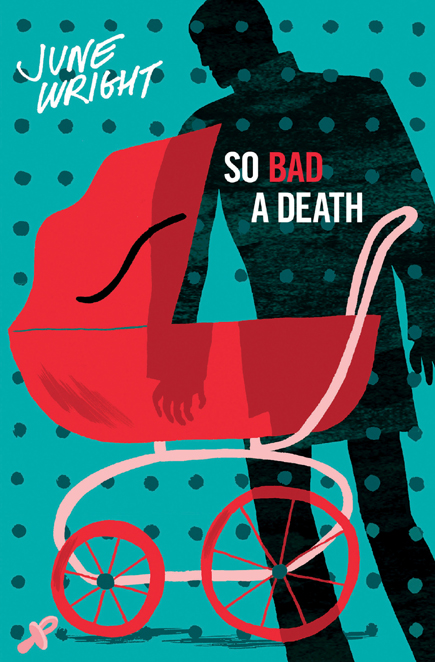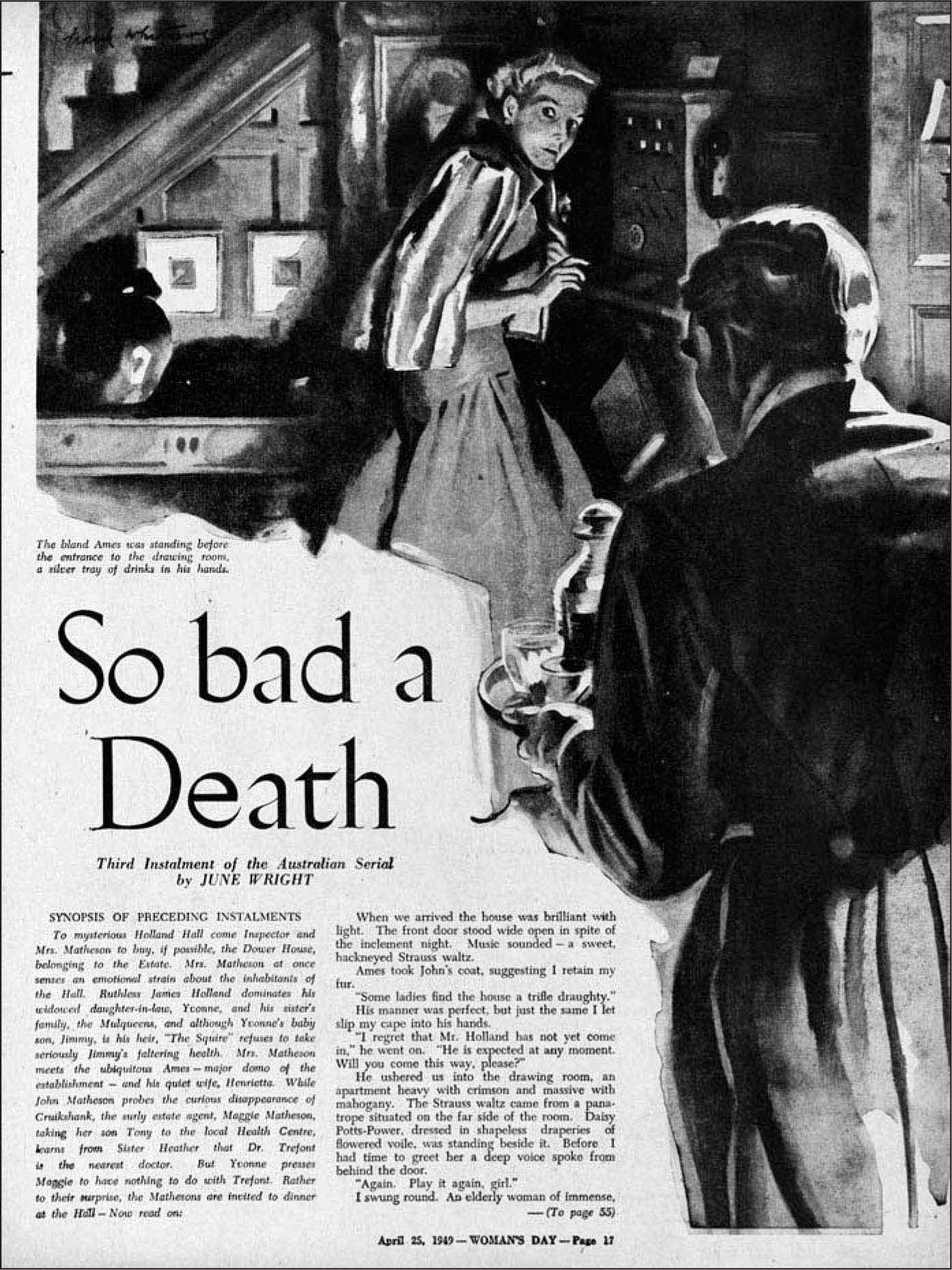So Bad a Death
Authors: June Wright


SO BAD A DEATH
BY THE SAME AUTHOR
Murder in the Telephone Exchange
The Devil's Caress
Reservation for Murder
Faculty of Murder
Make-Up for Murder
Duck Season Death

© 1949 June Wright
© 2014 the Estate of Dorothy June Wright
Introduction © 2014 Lucy Sussex
All rights reserved. No part of this book may be reproduced, stored in or introduced into a retrieval system, or transmitted in any form or by any means (digital, electronic, mechanical, photocopying, recording, or otherwise), without the prior written permission of the publisher, except by a reviewer, who may quote brief passages in a review.
| A Dark Passage book |
Cover design by Mike Reddy
Interior design and layout by Steve Connell/Transgraphic
Dark Passage logo by Mike Reddy
Country of manufacture as stated on the last page of this book
Library of Congress Cataloging-in-Publication Data
Wright, June, 1919-2012.
    Â
So bad a death / June Wright ; introduction by Lucy Sussex.
         Â
pages ; cm
    Â
ISBN 978-1-891241-60-4 (ebook)
    Â
1. Women detectivesâFiction. 2. MurderâInvestigationâFiction. 3. Melbourne (Vic.)âFiction. I. Sussex, Lucy, 1957- II. Title.
  Â
PR9619.3.W727S67 2015
  Â
823'.914âdc23
                                         Â
2014044271
Contents
An Interview with June Wright (1996)
June Wright was one of a small but highly talented group of Australian crime writers, active in the mid-twentieth century, of whom some of the most significant were women. They published internationally, maintained their careers and detectives over a number of books, and enjoyed a high public profile. That June Wright achieved such success is particularly impressive in that she was raising six childrenâin an era when, unlike her nineteenth-century predecessors like Mary Braddon and Anna Katharine Green, she did not have domestic help. June Wright was a housewife superstar well before Edna Everage, and far more gracious in the role.
It is important to put her into context, firstly as an Australian detective writer. She belonged to a long tradition, hardly surprising given the country's origins as a penal colony. Crime appears in Australian writing from its beginnings, mostly in the form of what we would now term true crime. Fictionâand in turn the crime genreâslowly emerged over the nineteenth century, fed by reportage, the Gothic, and theatrical melodrama. Form and content began to coalesce in the 1850s, a period of intense interest from prospective colonists hoping for gold. John Lang (1816-64), the first Australian-born novelistâand a lawyer, troublemaker and expatriateâwas also the first with a fictional detective. His 1855
The Forger's Wife
included the secondary character George Flower, based on a real Sydney thief-taker, though his methods were more violent than deductive.
Lang's most significant followers came ten years later, in the colony of Victoria. For much of the nineteenth-century, police fiction was hampered by class issuesâsnobbery with violence. Victoria's brief creation of a cadet system, young middle-class men recruited for an elite police force, made the detective a far less problematic
character for writers. The first Australian detective serials appeared in the
Australian Journal
in 1865, one writer being Mary Fortune (c. 1833-1909), who was married (bigamously) to a police cadet. She would write over five hundred stories in her âDetective's Album', the longest early detective serial anywhere in the world. Also figuring in the early issues of the
Australian Journal
was Ellen Davitt's
Force and Fraud
, the first Australian murder mystery novel.
June Wright, although a Melbourne writer, knew none of these antecedents. What she did know was Fergus Hume's
The Mystery of a Hansom Cab
, a semi-self-published novel by a New Zealander that first appeared in 1886 in Melbourne (where it was set), and was reprinted in London the following year. It became the biggest and fastest selling detective novel of the 1800s, and a key text in creating the publishing genre of detective fiction. The connection for Wright was personal: her grandfather Daniel Newham had known Hume and had himself attempted a âgreat Australian novel', never completed.
Following Hume's success, most Australian crime writers of the early twentieth century were expatriates. They lived in Britain, and wrote for that audience. Some, like the Geelong-born J. M. Walsh, even rewrote their Australian novels with English settings. As a teenager Wright did encounter a role model in Paul McGuire, who had moved in Catholic intellectual circles in London and continued to write Anglocentric detective novels after he returned to live in Adelaide. In contrast, her most famous peer, Arthur Upfield, was an English emigrant who celebrated the Australian landscape and, in his detective Bony, indigenous people. Other models came from Wright's preferred crime reading: the queens of crime fiction's golden age: Agatha Christie, Ngaio Marsh, Margery Allingham and the American Mignon Eberhardt. Although G. K. Chesterton was a fellow Catholic, she did not greatly care for his Father Brown stories.
Wright was a good student, but tertiary education for girls was not really an option in her family. Instead, she began working at Melbourne's central telephone exchange, which would supply her with a unique and interesting background for her first book. She married in 1941, and children followed quickly. When she drafted
Murder in the Telephone Exchange
in 1943, it was very much as an
outlet, as solitary brainwork. She wrote it in six weeks during the intervals when her firstborn, Patrick, was sleeping. Pregnant again, she immediately started another novel, but did not have the energy to proceed at that point.
Upfield had been reprinted by Doubleday in America during World War II, to great success. This had reminded international publishers that, as with Hume, Australia contained crimewriting gold. Several other Australia-based writers found book publication in 1944, notably A. E. Martin (three novels) and âMargot Neville', pseudonym of the sisters Margot Goyder and Anne Neville Joske. That same year, Wright chanced to see an advertisement for the âUnited Nations Literary Competition' while wrapping up vegetable scraps in newspaper. She typed up and sent off her manuscript, and this led ultimately to the publication of
Murder in the Telephone Exchange
with Hutchinson in 1948, and a three-novel contract.
Murder in the Telephone Exchange
was written from the perspective of a single woman, Maggie Byrnes, who detects and finds romance in the same narrative.
So Bad a Death
, published a year later, in 1949, again features Maggie, by now married with a small son. The novel is thus essentially a sequel, but it is in many ways a more skilled book, with Wright learning from the experience of writing. However, the time and energy she could devote to her work were now considerably limited: she had revised
Murder
in the maternity hospital after having twins. Her household comprised four children, with one twin proving severely mentally disabled, and this preoccupied her; in her memoir she could not recall much about the composition of her second and third novels.
Just as Wright's debut hit the target in its depiction of young working womenâwhich proved a factor in its successful reception when reprinted last yearâher second novel is similarly acute in drawing female lives. There is much in
So Bad a Death
that is autobiographic: a young mother seeking housing during a post-war shortage, as well as distraction from the domestic grind. Wright vividly and recognisably depicts the new suburb of Ashburton; in her memoir she recalls how people tried to identify the charactersâunsuccessfully. Something else she captures is the tension of women returning to domesticity
from war work, and finding it did not fulfill all of their needs.



